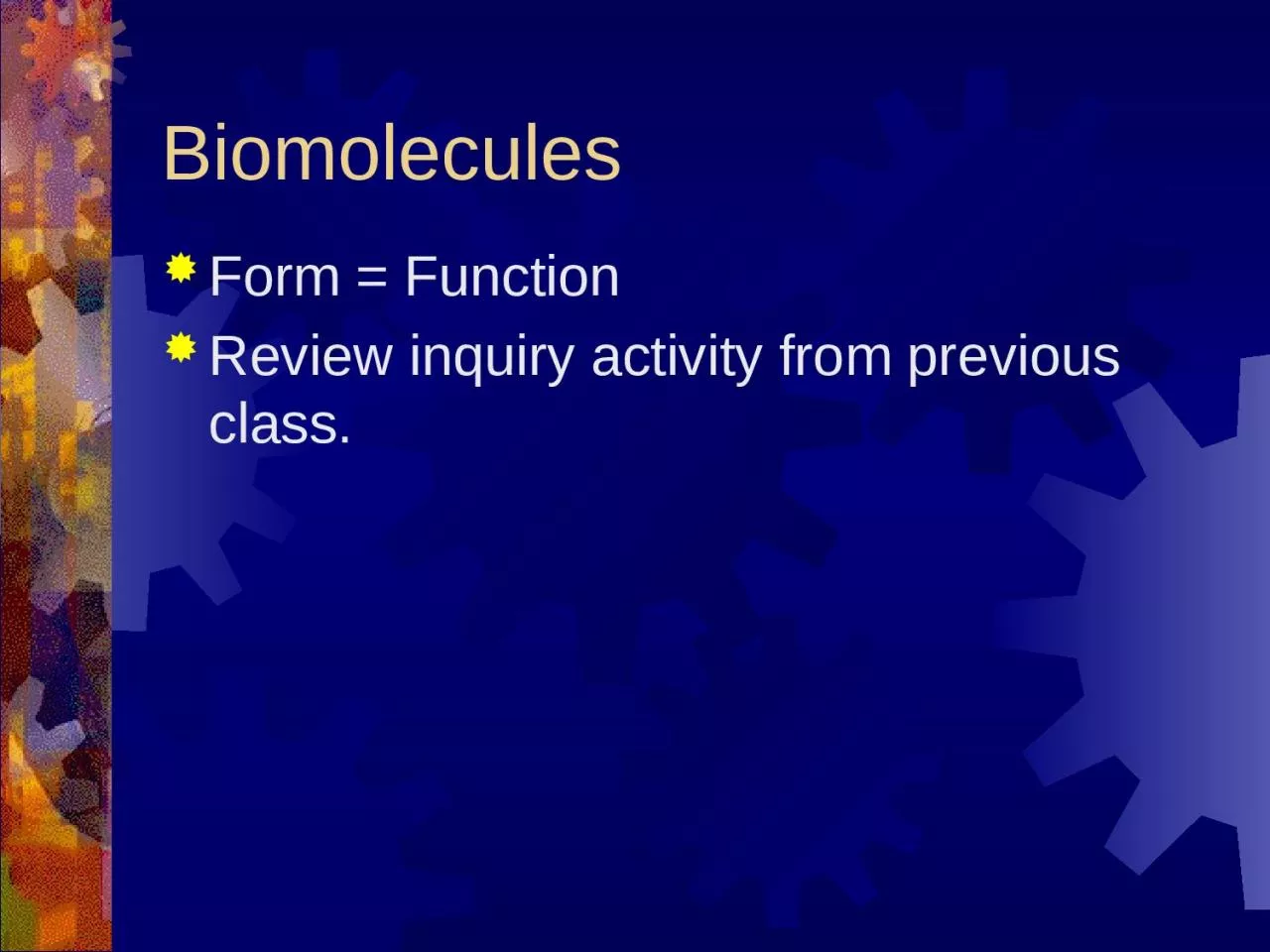

Review inquiry activity from previous class BIOMOLECULES MACROMOLECULES made by polymerization large compounds built by joining smaller ones together Smaller units subunits are called ID: 1032656
Download Presentation The PPT/PDF document "Biomolecules Form = Function" is the property of its rightful owner. Permission is granted to download and print the materials on this web site for personal, non-commercial use only, and to display it on your personal computer provided you do not modify the materials and that you retain all copyright notices contained in the materials. By downloading content from our website, you accept the terms of this agreement.
1. BiomoleculesForm = Function Review inquiry activity from previous class.
2. BIOMOLECULESMACROMOLECULESmade by polymerization-large compounds built by joining smaller ones together. Smaller units (subunits) are called monomers.4 major molecules important to life.Carbohydrates, lipids, nucleic acids and proteins.
3. BIO BUILDING BLOCKS
4. CARBOHYDRATES1:2:1 RATIO1 Carbon: 2 Hydrogen: 1 OxygenExample: the sugar glucose - C6H12O6Monomer – MonosaccharidePolymer - PolysaccharideMain source of energy for living thingsAlso has structural purpose for living things.Plant cells have cell walls made of celluloseAnimal cells store excess sugars as glycogen
5. CARBOHYDRATES
6. CARBOHYDRATES
7. CARBOHYDRATES
8. CarbohydratePolymerMonomer(subunit)
9. LIPIDSMade of Carbon and Hydrogen NOT soluble in water (hydrophobic)doesn’t mix with waterUsed to store energy, as chemical messengers (hormones, steroids)Part of the cell membrane (phospholipids).Saturated-Solid at room temperature. No double bondsUnsaturated-liquid at room temperature. Double bonds between Carbons.
10. LIPIDS
11. LIPIDS - triglyceride
12. Phospholipids – cell membrane componentPhospholipids: fatty acids bound to glycerol, a phosphate group replaces one fatty acid.Phosphate group is hydrophilic—”water loving head”“Water fearing tails” are fatty acid chains—hydrophobic
13. LipidCell walls
14.
15. PROTEINSComposed of Nitrogen, Carbon, Hydrogen, and Oxygen.Monomers are called amino acidsControl rate of reactionsFunction in transport and formation of bone and muscle cells.Folded shape is important in enzyme recognition process.
16. ProteinsMonomersPolymers
17. PROTEINS –amino acids
18. NUCLEIC ACIDSComposed of Hydrogen, Oxygen, Nitrogen, Carbon and Phosphorus.Subunits (monomers) are called nucleotides. Store and transmit hereditary information.Ex. DNA , RNA
19. NUCLEIC ACIDS - nucleotides
20. Nucleic AcidsMonomerPolymer
21. NUCLEIC ACIDS RNA—ribose DNA—deoxyribose
22. Video Review over Biomoleculeshttp://youtu.be/PYH63o10iTEhttp://youtu.be/n9eWhSbjSFIDehydration Synthesishttps://www.youtube.com/watch?v=ZMTeqZLXBSo
23. Difference in using energy fast or slow:Fast Chemical Reaction:http://www.youtube.com/watch?v=V9dhtre_HgUSlow Chemical Reaction:http://www.youtube.com/watch?v=l-mK3RUtZGs